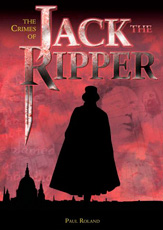


|
The Crimes Of Jack The Ripper
Extract from ‘The Crimes of Jack The Ripper’ (Arcturus Publishing 2006)
Introduction – The Myth of Jack The Ripper
On the afternoon of Tuesday, October 2 1888 carpenter Frederick Wildborn entered a dank, dark cellar in the new Metropolitan Police headquarters which was then under construction on the Thames Embankment and discovered a large brown paper parcel tied with string. When it was opened it was found to contain the dismembered, decomposing torso of an unidentified female whose severed arm had been fished out of the Thames a few weeks earlier. Her head and the remaining limbs were never recovered.
This gruesome discovery was the first in a series of macabre ‘torso murders’ which taunted the recently formed Criminal Investigation Department (CID) over the next 12 months.
At first the Police suspected they might be the work of Jack The Ripper, the Whitechapel murderer, who had apparently and inexplicably gone to ground after committing a number of brutal murders in the autumn of 1888, but the nature of the mutilations suggested otherwise. Evidently there was more than one psychopath stalking the streets of London, despatching his victims with impunity under the very noses of Scotland Yard.
Incredibly, neither The Ripper nor the torso murderer were ever identified, arrested or charged. But while the latter remains a footnote in the history of crime his evil twin continues to exert a macabre fascination more than a century later. And its all in the name, a name created by an unscrupulous but enterprising journalist to keep the killings on the front page and raise the stakes in a cut-throat circulation war.
Thanks to this macabre appellation Jack The Ripper has become lodged in the popular imagination as the personification of the debauched Victorian gentleman, a real life Mr Hyde freed from the subconscious of respectable society to embody its repressed sexuality. And yet, the reality was very different. The evidence presented in the following pages clearly contradicts the romanticised image of the top hated and cloaked aristocrat cutting through the swirling London fog with a small black bag, hell bent on ridding the streets of sin.

'The Crimes of Jack The Ripper' (Arcturus)
 'A Good Read With (For Once) A Plausible New Suspect', 25 Feb 2007 'A Good Read With (For Once) A Plausible New Suspect', 25 Feb 2007
Antony May (East Sussex, United Kingdom)
As a Ripperologist myself (and a Maybrickite) I approached reading this book with some caution. I must say however I found myself to be very pleasantly surprised. No Ripperologist can say with 100 percent certainty that their particular favourite suspect DEFINITELY was Jack and so, despite my belief he was James Maybrick I am still open for further ideas and enjoy reading of the other suspects. Bearing all this in mind, I can tell you that this book is an extremely interesting and well written book that I would recommend to both seasoned Ripperologists and newbies to the case. The text is punchy, easy to follow and the author (while not being arrogant) is prepared on occasion to 'put his head on the chopping block' when de-bunking (as he see's it) a particular ripper theory.
The identity of the new suspect the author names is (for once) someone that could quite plausably have been Jack (and if true would go a long way to explaining the puzzling reactions at the time of one of the few people likely to have actually seen the ripper). The discussions concerning overseas characters mentioned in connection to ships coming and going at the time of the murders were also of interest and overall I would thoroughly recommend this book. Excellent stuff!
 'the best ripper book i have ever read...,' 30 Dec 2006 'the best ripper book i have ever read...,' 30 Dec 2006
A. I. R. Chick "deviant__"
Firstly this is the only book i have picked up that quotes the full number of victims that the yard has attributed to "jack" most only claim 5 victims,
Secondly this book attempts to use forensic evidence where possible however it make the point that the police were ill equiped to deal with the case, and didn’t collect much evidence (ie finger prints) while personally i feel that with the lack of evidence collected at the time the case will never be cracked, this book presents a well rounded account of Victorian Britain and the murders as well as a round up on the usual suspects as well as a new suspect, the only think i feel that could have been added to this book would be a reference section, much as would be found in a modern science text book.
|
|
| |
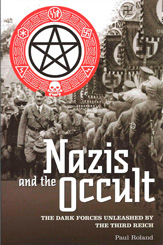


|
Nazis And The Occult
Extract from ‘Nazis and the Occult – The Esoteric Origins of the Third Reich’ (Arcturus Publishing 2007)
The Dawn of the Magicians
‘Natural magic or physical magic is nothing other than the deepest knowledge of the secrets of nature.’ (Del Rio 16th century)
The true meaning of the words ‘magic’ and ‘occult’ are misunderstood by those outside the esoteric tradition. In the popular imagination they evoke lurid images of men in voluminous robes adorned with exotic symbols conjuring demons from the abyss, or cackling old hags cavorting naked under the full moon. Such scenarios are however, the invention of the medieval mind and specifically of the early church which created the devil and his disciples to frighten followers of the ‘old religion’ into abandoning their beliefs and instead put their faith in a messianic saviour who promised to redeem them from original sin. Despite the recent rekindling of interest in paganism and the paranormal such superstitions and a general wariness of the occult still persists to this day.
It is no wonder then that few can accept the idea that Hitler and his Nazi regime might have been practitioners of the black arts. They cannot imagine the brown shirted bullies of the SA and the black uniformed legions of the SS forming a satanic coven, or Hitler and Himmler standing in a magic circle uttering the ‘barbarous words of invocation’ to guarantee world domination. But if the original meaning of the word ‘occult’ is understood to mean simply that which is hidden or unknown and a truer definition of magic is that which involves the exercising of the will to bring about a change that would not occur naturally, then a compelling case can be made for Hitler having practised black magic and the Nazi era being the manifestation of the daemonic.
Such a scene does not, of course, appear like Mephistopheles at the acolytes’ invitation. The stage must be set, the time of the ritual chosen to coincide with favourable alignments of the stars and the necromancer needs to prepare himself or risk being overwhelmed by the demonic forces he seeks to invoke. Such preparations were in place in Germany at the turn of the 20th century.

‘Nazis and the Occult’
 A very good research. 23 Nov 2013 A very good research. 23 Nov 2013
By Argyris Periferakis
The author has a thorough knowledge of the subject and examines it from a lot of different angles. There is no prejudice by the author and it certainly provides a new, and unknown, insight of the Third Reich's leadership and convictions.
 Sober take on Nazis and the Occult, 23 April 2013 Sober take on Nazis and the Occult, 23 April 2013
By Weyland Yutani
I was quite surprised how even-handed and sober this book was. It could have quite easily been a hysterical take on this subject, but the arguments put forward and assessments of the evidence was quite sensible. Overall a very good read on an interesting subject.
 Surprising History, 30 Mar 2013 Surprising History, 30 Mar 2013
By Xenophon. (Fife, Scotland.)
This is a very illuminating book, which details the superstitious and downright crazy beliefs involved in the Nazis cult. Even during the Second World War many top level decisions were influenced by these beliefs, and superstitions, which obviously were often counterproductive. An overlooked element in the conventional history of the war.
 Nazi Occult is a damn good read, 8 Nov 2012 Nazi Occult is a damn good read, 8 Nov 2012
By Mr. Gary Marshall (UK)
This book covers a subject that has been greatly neglected when talking about the Nazi period in Germany. It’s a book which is easy to read and gives an insight in to the minds of Hitler and the senior Nazis. This is the other side of a regime that thought they could conquer the world not just by force of arms but by gathering the dark forces as their ultimate weapon.
|
|
| |
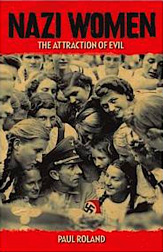


|
Nazi Women - The Attraction Of Evil
After the failure of the Weimar Republic, the Nazis believed their mission was to masculinize life in Germany. Goering told women, “Take a pot, a dustpan and a broom, and marry a man,” but many became active Nazis, helping to spread wide the net of evil. By 1944, 40 percent of the Gestapo was staffed by women, concentration camps employed legions of Aufseherinnen (female guards), and callous nurses ran the euthanasia program. Prominent female Nazis included First Lady of the Third Reichb Magda Goebbels,Eva Braun, Lina Heydrich, Carin GC6ring and Unity Mitford. A cult of adoration developed round the unmarried Hitler. Love is meat for husbands, but my love for Hitler is stronger. I would give my life for it, said Magda Goebbels.

‘Nazi Women’
A first-class read.
By A. Ali on 23 Sep 2014
Women were second-class citizens in the Third Reich, expected to stay at home, dress demurely and have babies for the Fatherland. Author Paul Roland starts by raising questions about the sexuality of Adolf Hitler and his relationships with women, then proceeds to run every sector of German society under his microscope. You’ll meet millionaires’ wives who backed the Nazi Party, female Fuhrers who ruled the roost over their own sex, the screen goddesses of the UFA Studios chased by Josef Goebbels, female concentration camp guards who were every bit as brutal as their male counterparts and even an aberrant English aristocrat, Unity Mitford, a fascist fixated on Hitler.
On the face of it, Nazis were keen to bolster community spirit and make women the beating heart of the New Order household, but the Party rode roughshod over all values, so that nurses ended up administering lethal injections for the euthanasia programme, neighbours betrayed neighbours, and Aryan stud farms and systematic abductions became an acceptable way of increasing the German population. It’s all grist to Roland’s mill.
|
|
| |
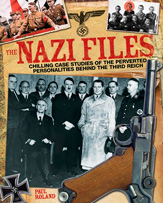


|
Nazi Files
Introduction
More than half a century after the Second World War the Nazis continue to exercise a morbid fascination despite their abhorrent ideology and murderous deeds. But were they innately evil, or merely fatally flawed individuals corrupted by their messianic Fuhrer Adolf Hitler?
Evil is a theological concept which assumes that a malevolent force exists in the Universe with the power to influence human affairs. But if this is a fallacy and we are all responsible for our own thoughts and actions, how do we explain the destructive impulse that impelled Hitler and his fanatical followers to order the cold-blooded murder of millions and the unquestioning obedience of those who implemented such orders with unbridled enthusiasm?
How could a devout Catholic such as Franz Stangl, commandant of Sobibor and Treblinka, send thousands of innocent men, women and children to the gas chambers? And how did Rudolf Hoess, commandant of Auschwitz, continue to live a normal family life with his children playing within sight and sound of the crematoria? Were the inhuman experiments conducted by Dr Joseph Mengele in Auschwitz acts of pure sadism, or did he truly believe that his ‘research’ had scientific value? What possessed devoted mother Magda Goebbels to murder six of her children? And how did educated and cultured men such as Reinhard Heydrich and architect Albert Speer justify the brutal liquidation of the ghettos and the slave labour program which saw thousands of men, women and children starved, beaten and worked to death for their ‘superior’ Aryan masters?
Such scenes may have been common in biblical times, but the barbarity meted out by the Nazis took place in the era of commercial air travel, wireless communication, cinema, and the motor car. By the middle of the 20th century ignorance, superstition and blind obedience were assumed to have been a feature of the Dark Ages and yet, Hitler and the Nazi leadership succeeded in seducing a nation that had produced some of the most significant philosophers, scientists and artists of the age before leading the nation into a hell entirely of their own making.
|
|
| |
“Roland’s compelling account is highly readable.”
Professor Nicholas Goodrick-Clarke. |
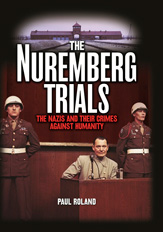


|
The Nuremburg Trials
Foreword
Why another book about the Nuremberg War Crimes trial? It is true that the story is well known and has been retold many times, but it bears repetition because with the passing of time the Nazis have assumed almost mythic status in the minds of those who did not experience the war or the horrors of the concentration camps. There is a very real danger that for subsequent generations they will be reduced to two dimensional villains – no more real than the sinister SS caricatures in the Indiana Jones films.
Of more importance, though, is that the lessons of Nuremberg do not appear to have been learnt. There are still those who deny the Holocaust - despite the fact that to do so is now a crime in many European countries including Germany - and they do so in the face of the facts which are presented here in the form of first hand accounts and verified by the accused themselves in their own words.
Another reason why I felt compelled to write this account was that I managed to unearth several personal recollections which, to the best of my knowledge, had never been published in book form. These are not of great length, nor even of great significance from a historical point of view, but they reveal certain aspects of the trial and of the personalities involved that are not well known. But, of more importance, they underline the impression that all of the characters in this human catastrophe were quite ordinary people living through extraordinary times. And that includes the defendants.
The Nazis continue to hold a morbid fascination for many people, but stripped of their Satanic symbolism and dispossessed of their power over life and death which fed their fanatical arrogance, Hermann Goering, Albert Speer, Von Ribbentrop and the rest of the Hitler gang were reduced to their essence, which in many cases was as pitiable as it was disturbing. Here was the ‘banality of evil’ laid bare, the very embodiment of the untermenschen (the subhuman of Aryan master race mythology), blindly obeying immoral orders without recourse to their own conscience. These were men of diverse backgrounds – able military leaders, petty bureaucrats and mechanical functionaries some of whom should have known better but who willingly sold their souls to bring a madman’s nightmares to reality, feeding his neurosis and propagating his racist paranoid propaganda without considering where it would inevitably lead to. Deprived of the pretence of Teutonic heroism and denied the ritual staging of their Wagnerian party rallies, the Nuremberg defendants were finally forced to face the sordid reality which their racist ideology and extreme nationalism had wrought upon the world.
It is a disquieting fact that we tend to find villains more interesting than their victims - in fiction and in reality - but the Nuremberg trials revealed that in real life criminals and murderers are invariably colourless individuals lacking personality as well as compassion and conscience. It is their victims who frequently display courage and endurance beyond normal human experience. And that, I hope, is one aspect that I have brought out in this account of the trials. For the final reason for writing this account of the ‘Trial of the Century’ was to give voice to the survivors of Nazi atrocities who witnessed unimaginable horrors and found the courage to continue with their lives. Women such as Clara Greenbaum…

‘Nuremberg Trials’
 Towser T, 21 July 2014 Towser T, 21 July 2014
By Stephen Timms
This is a concise and well-judged exposition of the Nuremberg Trials. It covers the main thrusts of the arguments for and against the trials at the time. It also gives one a flavour of the courtroom drama that prevailed and the key players. It is a "must" for anyone looking for a short-hand account of this important event in World legal history.
‘Nuremberg Trials’
 Informative, 4 May 2014 Informative, 4 May 2014
By judith bywater
Informative but written in a clear and concise way that is easy to follow. A must for anyone studying the holocaust
 The Nuremberg Trials: The Nazis and their crimes against The humanity by Paul Roland, The Nuremberg Trials: The Nazis and their crimes against The humanity by Paul Roland,
20 Nov 2013
By mark savage
An informative and engaging narrative which provided a clear picture of the events and characters involved.
The book was easily readable and would be accessible to a broad spectrum of reader, particularly young adults who may know little or nothing of the second world war and the amazing efforts to deal with the aftermath in a balanced way. Highly recommended.
 Fascinating, 1 Sep 2013 Fascinating, 1 Sep 2013
By Ms. Dorothy Shields (uk)
This was a serious book about a shocking subject. The author had comprehensively researched and it is written in a way that encourages you to read, It’s not dry and heavy - I'd commend this to anyone.
 Excellent study, 23 April 2013 Excellent study, 23 April 2013
By Daniel John Cogan
This can be seen as the concise book of the Trials. Whilst not as long or in depth as others, it presents all of the main facts in an easy to follow way. A great little book for someone wanting to know the basic story of the Nuremberg Trials!
|
|
| |
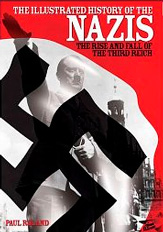


|
The Illustrated History Of The Nazis
Introduction - A Question of Evil
This book differs from conventional histories of the Third Reich in that it argues that the Nazi state was more than a socio-political phenomenon, it was the manifestation of its Fuhrer’s fatally flawed personality.
Sadistic criminals, serial killers and brutal dictators are routinely referred to as ‘Evil’ and Adolf Hitler frequently cited as the personification of the malevolent spirit manifest in Man. But malicious spirits are a creation of the primitive, irrational mind. Common sense contends that evil is entirely man made, that it is a deliberate, wilful act by an individual who seeks satisfaction in destruction out of sheer spite and a lack of empathy for their victims.
We may not believe in the Devil these days, but we continue to demonise dictators so that we are not forced to see them for what they really are - a shadow of ourselves, the embodiment of our darkest fears, a reflection of what we could become if we abandoned conventional rules of conduct and indulged our basest instincts.
Historians argue that Hitler was an aberration, the product of a violent, unstable era in European history which could only have occurred in the aftermath of the First World War. The milieu from which he emerged was a form of collective shell shock which they reassure us is unlikely to occur again. There will always be tin pot dictators throwing their weight around, suppressing their own people and threatening their neighbours, but Hitler and his equally blood thirsty ally, ‘Uncle’ Joe Stalin were the last in a line of conquerors going all the way back to Genghis Khan. Such men will be an anathema in the 21st century, or so the historians would have us believe.
The same academics have explained the Nazi party’s rise to power as being due exclusively to socio-political factors. But it is the purpose of this book to show that Hitler did not wage war solely to avenge Germany’s defeat in 1918. His insatiable appetite for conquest was not driven by territorial ambitions alone. Nor by the desire to restore German honour and pride. The former Austrian corporal who rose to unprecedented power as absolute ruler of the Third Reich - was consumed by the belief that divine providence had entrusted him with a sacred mission to subjugate all ‘inferior’ races and eradicate the Jews from the face of the Earth.
Hitler created and nurtured the climate of suspicion, fear and deceit which pitted his own ministers against each other in the belief that they would be too occupied in squabbling among themselves to plot against their Fuhrer. And once the initial euphoria of swift and easy victory over France and the low countries died down and the reality of a protracted war with Russia filtered through, the German people woke up to the fact that they were living in a fascist police state where anyone with a grudge could anonymously inform on a family member, friend or neighbour knowing that their suspicions would be ruthlessly acted upon by the Gestapo, who routinely resorted to torture to extract a confession. Such conditions are not created by a unique combination of random historical events. Nazi Germany was one man’s nightmare world made manifest. To understand how The Third Reich came into being and why the German people worshiped Hitler as their saviour even as their cities crumbled around them in the last days of 1945, it is necessary to appreciate what kind of a mind conceived the Nazi state.


...he was a man before he became a monster... 21 Feb 2013
By A. Ali
It's less than a century ago but sometimes the rise of the Nazis seems like ancient history. Paul Roland makes it all seem very contemporary and goes a long way to helping me understand how Hitler and his supporters became so powerful. As well as Roland's writing, there are some brilliant pictures, including one of Hitler during the First World War, with a rather rakish moustache, which serves as a poignant reminder that he was a man before he became a monster.
 Illustrated History of the Nazis (hard cover) 24 Mar 2012 Illustrated History of the Nazis (hard cover) 24 Mar 2012
By Henry Waterman - Published on Amazon.com
The subtitle of this book, "The nightmare rise and fall of Adolph Hitler" more aptly conveys what Paul Roland's book is really about. It is more about Hitler than the Nazi movement itself, despite the fact the two are inseparable. The author gives many different opinions of Hitler and makes many assumptions about him that may or may not be accurate. But I found his ideas about Hitler riveting. His insights into Hitler's mind and personality are very interesting. Having written many other books on related and also different subjects, Roland is no doubt a very knowledgable writer. And he writes well. It is easy to understand what he is saying, whether the reader accepts what he says or not. His study of Hitler from his birth until his death is rather comprehensive. I would recommend the book more to readers who have read many books on Hitler than to those who have not read much on Hitler because much of what Roland says is debatable and the reader needs to already have a deep understanding of Hitler to be able to intelligently assess the allegations Roland makes about Hitler and the theories he advances about him. I would remiss in not indicating the book contains many pictures, several that have been depicted in other publications, but several I have never seen before.
‘Illustrated History of the Nazis’
Father Bear on Amazon
The most factual, and engaging read I have had in a long time.
|
|
| |
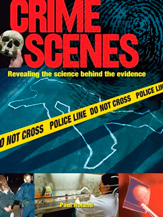


|
Crime Scenes
Extract from ‘Crime Scenes’ (Arcturus Publishing 2006)
Introduction
A partially clothed body of an unidentified woman is discovered on the front lawn of a house in a quiet, respectable suburban neighborhood of Florida on a Sunday morning by a man out walking his dog. The police are called to the scene which they secure with yellow perimeter tape printed with the warning ‘Crime Scene - Do Not Cross’. As one officer ushers the swelling crowd of curious onlookers to the other side of the street his partner radios in for a homicide detective and a team of forensic investigators to comb the area for evidence.
The scene will be familiar to regular viewers of the popular US TV series CSI - Crime Scene Investigation, which pulls in a stateside audience in excess of 50 million and millions more around the world. But this particular crime was real and is one of many thousands of homicides reported every day of the year in towns and cities across the globe. The language and the uniforms may differ depending on the country, but sadly, murder is universal and a feature of life going back all the way to when Cain killed Abel.
In the past the authorities have had to rely on fingerprints, eye witnesses and occasionally the culprit’s compulsion to confess, but in recent years forensic science has made incredible advances with the advent of DNA analysis and trace evidence identification techniques that have given investigators what appear to be infallible tools for identifying the guilty and putting them where they belong – behind bars.
In the fictional TV show a single hair, fibre, or flake of paint is sufficient to identify the killer, arsonist, robber, rapist, or terrorist and place them at the crime scene. With their gleaming laboratory and state-of-the-art, high-tech diagnostic equipment at their disposal it is usually only a matter of hours before one of the glamorous CSI techs matches the fatal bullet to the suspect’s gun or reveals the full history of the deceased from a single hair, leaving the detective in charge of the case to take the ‘perp’ into custody as the closing credits roll.
If only it was that easy in real life, all the criminals would be in handcuffs and law abiding citizens could sleep soundly in their beds.
While it is true that ‘the evidence never lies’ and that a single fibre is often sufficient grounds to secure a search warrant or make an arrest, rarely is one item of evidence enough to send someone to jail or the electric chair. In the real world the law demands irrefutable physical evidence backed up by eye witness testimony and preferably a confession too, if a conviction is to be secured. However, suspects are rarely as cooperative in real life as they appear to be on TV. They don’t give up their liberty without a fight and the Police never underestimate the ability of a smart lawyer to undermine witness testimony and discredit evidence in the hope of raising the spectre of ‘reasonable doubt’.
Fortunately forensic science is continually developing making it increasingly difficult for criminals to get away with their crimes.
|
|
| |
“Roland has written an important book…a fascinating read and a unique approach to the subject.”
(from the Foreword by senior FBI profiler Roy Hazlewood)
|
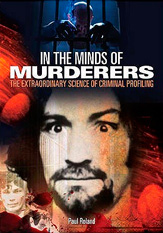


|
In The Minds Of Murderers
Introduction – Hearts of Darkness
‘Criminals think differently from responsible people.’ Dr Stanton Samenow, ‘Inside The Criminal Mind.’
This is not another book about serial killers, although you will find some of the most notorious mass murderers of modern times profiled in these pages together with sexual sadists, serial rapists, arsonists, extortionists, bank robbers, war criminals, tyrants and terrorists.
Nor is it yet another rehash of famous cases that will be overly familiar to connoisseurs of True Crime. It is far more interesting than that because this book explores the new science of criminal profiling and what it reveals about the nature of evil, specifically what motivates men, women and sometimes even children to commit the most appalling acts imaginable.
Offender Profiling, or forensic psychology to use the clinical term, was largely but not exclusively developed by the FBI Behavioural Analysis Unit at Quantico, Virginia during the late 1970s and 80s and is now widely practiced throughout the world by law enforcement professionals who have come to realise that even forensic science is not infallible.
Profiles can be prospective which means that they can be used to predict which individuals in a particular segment of society have the potential to offend, or they can be retrospective which involves identifying which type of individual might have been responsible for a specific crime or series of crimes from the behaviour they exhibited at the scene. Retrospective profiles are generally favoured by intelligence agencies who seek to identify potential terrorists before they commit an atrocity, but this approach is controversial and has come under increasing criticism because it can lead to racial stereotyping, whereas retrospective profiling aims to create a behavioural composite of an unknown subject or UNSUB, to narrow the focus of an investigation rather than pointing a finger at a specific individual.
Hundreds of cases each year in the United States alone benefit from the insights provided by BSU profilers who have been able to claim a 92% accuracy rating every year between 1978-1994. The standard FBI profile will feature fifteen key points or clues to the type of personality who should be considered responsible for the offence. If two of these points prove to be inaccurate the bureau considers it one of their rare ‘mistakes’.
Former FBI special agent Russell Vorpagel described the profiling process as a psychological autopsy and compared the profile itself to an Impressionist painting which is composed of numerous brush strokes none of which may be significant on their own but together create ‘a meaningful picture’.
‘In The Minds of Murderers’ reveals the secrets of this new science, specifically how a profiler can tell when a crime scene has been staged or altered and whether a murder victim has been posed to divert attention from the intended offence, usually robbery or rape. It describes the extent to which fantasy and control compels sadistic offenders to abduct and torture total strangers, the significance of the serial killer’s ‘signature’ and what part stressors play in pushing a perp over the edge.
It details what the choice of weapon and ferocity of an attack reveals about the assailant, what can be gleaned from a body that has been mutilated post-mortem and what the manner of disposal and the location tells investigators about the killer’s relationship to the victim. Was it simply dumped, partially covered or buried?
But the potential benefits of profiling are not limited to murder cases. An arsonist’s choice of accelerant, the tone of an extortionist’s letters and a hostage taker’s list of demands all help to disclose the type of person responsible for these crimes, their state of mind and the level of threat that they pose.
From the most seemingly insignificant clues an experienced profiler can determine the offender’s sex, age, physical appearance, personal circumstances, background, occupation and even the model and condition of the car they drive. By recreating the crime from clues left at the scene it is also possible to predict the perpetrator’s next move.
Using a mixture of behavioural analysis, personal experience and intuition leading profilers such as the FBI’s John Douglas (the inspiration for Special Agent Jack Crawford in ‘The Silence of the Lambs’) and England’s real life ‘Cracker’ Dr Paul Britton can get inside the mind of a child molester or under the skin of a psychopath to devise strategies that can be used to track and trap these predators.

‘In The Minds of Murderers’
 An amazing read. 19 Aug 2014 An amazing read. 19 Aug 2014
By elizabeth davies
Such an in-depth, well written book that gives a lot of insight. A must read. You will not be disappointed!
|
|
| |
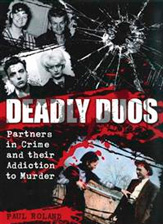


|
Deadly Duos - Partners in Crime and their Addiction to Murder
Proving that sometimes it really does take two to tango, this hardcover, full-color edition is a collection of true-life stories which show the very worst that can happen when two evil individuals hook up with each other. Serial killers and sadistic sex murderers are, by nature, solitary predators who keep their sordid secret to themselves until painstaking detective work, profiling, forensics or sheer luck leads to their capture and conviction.
However, an increasing number of these brutal crimes are being perpetrated by two or more individuals acting together. Together they are twice as dangerous, twice as deadly. By working in tandem they can cover each other's tracks, subdue their struggling victims and dispose of bodies more easily. What makes such seemingly ordinary individuals hunt together, feeding off each other's addiction to cruelty? Is it a power trip? Do they need the approval of an admiring partner? Or is it just tainted love spiraling out of control?
Fully illustrated with black and white photographs and page decorations, this collection of horror stories is a necessary addition to any true-crime fan's library. It warms the human heart to see a couple in love. Unless, of course, the couple is one of the deadly duos profiled in this book.

‘Deadly Duos’
 Warning: Don't read the stories all in one go... 21 Feb 2013 Warning: Don't read the stories all in one go... 21 Feb 2013
By N.O.
Oh boy, this is tough reading and I wouldn't recommend reading too many of these stories in one go, but it has to be said that Paul Roland has done a hell of a good job in getting across the full horror of what these people did. Most of them make Bonnie and Clyde look like Jack and Jill and I guess the lesson is that when too sick psychos come together there really is no limit to the depths they'll sink to.
|
|
|
![]()
![]() 'A Good Read With (For Once) A Plausible New Suspect', 25 Feb 2007
'A Good Read With (For Once) A Plausible New Suspect', 25 Feb 2007![]() 'the best ripper book i have ever read...,' 30 Dec 2006
'the best ripper book i have ever read...,' 30 Dec 2006


















